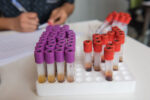Frexalimab reduces blood NfL levels over 1 year in Phase 2 MS study
Treatment also resulted in fewer new or enlarging brain lesions in patients
Written by |

Nearly one year of treatment with frexalimab, an antibody being developed by Sanofi, significantly reduced the blood levels of neurofilament light chain (NfL), a biomarker of nerve cell damage that typically is elevated in people with multiple sclerosis (MS).
That’s according to new data from a company-sponsored Phase 2 clinical study (NCT04879628), which is testing two frexalimab doses against a placebo for 12 weeks, or about three months, followed by a long-term, open-label extension period.
Nearly one year of data also indicated that frexalimab resulted in sustained reductions in the number of active and new or enlarging brain lesions in people with relapsing forms of MS, including relapsing-remitting MS or active secondary progressive MS.
These data support frexalimab’s mechanism of action and the company’s move into Phase 3 clinical testing in patients with relapsing forms of MS (NCT06141473) and nonrelapsing secondary progressive MS (NCT06141486). Both studies have begun enrolling patients at sites globally.
The new data were presented in two posters at the 10th Congress of the European Academy of Neurology (EAN), held June 29 to July 2, in Helsinki.
“These results, alongside the previously reported Phase 2 efficacy and safety results, further show that frexalimab’s novel mechanism of action has the potential to deliver meaningful improvements for people living with this chronic and debilitating disease,” Erik Wallström, MD, PhD, Sanofi’s global head of neurology development, said in a company press release.
New lesions reduced by 89% with high-dose frexalimab after 3 months
Frexalimab is a next-generation anti-CD40L antibody designed to inhibit the CD40/CD40L pathway, which is key for the activation of immune cells in the body. It is expected to control both new and ongoing inflammation in MS without reducing the number of circulating white blood cells or causing blood clots, a serious side effect of earlier CD40L inhibitors.
The ongoing Phase 2 study is testing how safe frexalimab is and how well it works against a placebo in 129 adults with relapsing forms of MS.
In the first part of the study, participants were randomly assigned to one of two doses of frexalimab — 1,200 mg or 300 mg — or a placebo for 12 weeks. The high dose was given via monthly infusions into the bloodstream after a loading dose of 1,800 mg, while the low dose was administered through subcutaneous or under-the-skin injections once every two weeks, with a 600 mg loading dose.
After 12 weeks, researchers observed an 89% reduction in new lesions with active inflammation in the high-dose group versus the placebo group, and a 79% reduction with the low dose — meeting the trial’s primary goal. Reductions in the total number of new or enlarging lesions also were observed with both doses.
Among the initial participants, all but four — 125 patients or 97% — chose to join an open-label extension in which all received frexalimab at a low or high dose. A total of 112 (87%) received treatment for at least 48 weeks, or nearly one year.
In a presentation titled “Safety and efficacy of frexalimab in relapsing multiple sclerosis: 48-week results from the phase 2 open-label extension,” researchers now reported that these benefits in MRI disease activity were sustained for up to 48 weeks.
The benefits were particularly evident in the group of patients who received high-dose frexalimab from the start of the Phase 2 trial, among whom 96% were free of lesions with active inflammation.
Still, the other groups, even those with participants who were initially on the placebo and then transitioned to frexalimab, had more than 85% of patients without inflammatory lesions.
NfL levels, measured in patients’ blood, seen as key biomarker
In another presentation, “Frexalimab reduces plasma neurofilament light chain in relapsing multiple sclerosis: Week 48 data from a phase 2 trial,” researchers shared NfL data from the Phase 2 trial.
NfL is a protein found in axons, the long projections of nerve cells that send out electrical impulses. Upon nerve cell damage, NfL gets released into the blood or the cerebrospinal fluid — the liquid surrounds the brain and spinal cord.
“As our science and diagnostic tools have evolved, so has our understanding of multiple sclerosis,” said Patrick Vermersch, MD, PhD, a study author and a principal investigator and neurologist at the University of Lille, in France.
“We now know that NfL levels may be related to both acute inflammatory damage and chronic diffuse neuronal loss leading to disability progression, strengthening its position as a key biomarker of nerve cell damage in people with multiple sclerosis,” Vermersch said.
When the study started, the average levels of blood NfL were similar across groups. But all treatment groups experienced reductions in blood NfL levels after 48 weeks. The greatest reduction (41%) also was observed in patients who received high-dose frexalimab through the entire 48 weeks.
As our science and diagnostic tools have evolved, so has our understanding of multiple sclerosis. … We now know that NfL levels may be related to both acute inflammatory damage and chronic diffuse neuronal loss leading to disability progression, strengthening its position as a key biomarker of nerve cell damage in people with multiple sclerosis.
Patients who always received treatment with the low dose experienced a 35% reduction, whereas those who started on a low or high dose of frexalimab after 12 weeks on a placebo experienced a reduction of 33% and 24%, respectively. That reduction increased to 39% in both placebo-frexalimab groups when considering only the period they were on frexalimab.
“These data presented at EAN suggest that CD40L inhibition may reduce nerve cell damage in people with multiple sclerosis and reinforce the potential of frexalimab to slow or halt disease progression for people living with this disease,” Vermersch said.







